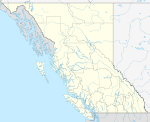Cariboo Regional District
This article needs additional citations for verification. (September 2014) |
Cariboo | |
|---|---|
| Cariboo Regional District | |
 Flag  Logo | |
Major communities | |
 Location in British Columbia | |
| Country | Canada |
| Province | British Columbia |
| Administrative office location | Williams Lake |
| Government | |
| • Body | Board of directors |
| • Electoral areas / municipalities |
|
| Area | |
| • Total | 80,609.75 km2 (31,123.60 sq mi) |
| Population (2016)[1] | |
| • Total | 61,988 |
| • Density | 0.77/km2 (2.0/sq mi) |
| Website | cariboord.bc.ca |
The Cariboo Regional District spans the Cities and Districts of Quesnel, Williams Lake, 100 Mile House, and Wells in the Central Interior of British Columbia.
Geography[]
The Cariboo Regional District (CRD) in the Central Interior of BC encompasses 80,252 square kilometers of land.[2] The Cariboo and Coastal mountain ranges hug the CRD on its west and east side boundaries. The region straddles Highway 97 from 70 Mile House in the south to 5 km south of Hixon in the north. It belongs to the PDT/PST time zones.[3]
Incorporated municipalities[]
- District Municipality of 100 Mile House
- City of Quesnel
- District Municipality of Wells
- City of Williams Lake
Communities[]
Other communities[]
- Alexis Creek
- Anahim Lake
- Horsefly
- Lac La Hache
- Likely
- Lone Butte
- McLeese Lake
- Nazko
- Nimpo Lake
- Riske Creek
- Tatla Lake
- Forest Grove
- 150 Mile House
Features and Amenities[]
The Cariboo Regional District provides region-wide library services, recreational facilities, and local fire protection.
Demographics[]
2016 Census[]
The 2016 Canada census population data for the Cariboo was 61,988 persons living on a land area of 80,629.34 km² (31,129.9 sq mi).
| Ethnic groups in Cariboo RD (2016) Source: [1] |
Population | % | |
|---|---|---|---|
| Ethnic group | European | 46,585 | 76.4% |
| Aboriginal | 11,040 | 18.1% | |
| South Asian | 1,045 | 1.7% | |
| Filipino | 330 | 0.5% | |
| Chinese | 230 | 0.4% | |
| Japanese | 195 | 0.3% | |
| Black | 165 | 0.3% | |
| Korean | 135 | 0.2% | |
| Latin American | 80 | 0.1% | |
| Southeast Asian | 50 | 0.1% | |
| West Asian | 20 | 0% | |
| Arab | 0 | 0% | |
| Multiple minorities | 120 | 0.2% | |
| Visible minority, n.i.e. | 50 | 0.1% | |
| Total population | 61,988 | 100% | |
Rural Representative Elections[]
Electoral directors[]
Twelve electoral area directors and four municipal directors govern the affairs of the Cariboo Regional District. The electoral area directors are elected by area voters, and municipal directors are appointed by their municipal council. All directors serve for a four-year term.
Electoral areas[]
Regional District Electoral Areas are A, B, C, D, E, F, G, H, I, J, K and L.
Electoral areas have no administrative or governmental significance; they are used only to elect rural representatives to regional district boards.
Literature[]
The Cariboo District and 100 Mile House are featured prominently in Al Purdy's poem "The Cariboo Horses" to examine the tradition of equinity against human civilization.[4]
References[]
- ^ a b "Population and dwelling counts, for Canada, provinces and territories, and census divisions, 2016 and 2011 censuses – 100% data (British Columbia)". Statistics Canada. February 8, 2017. Retrieved July 9, 2019.
- ^ "About Us". www.cariboord.ca. June 2, 2021. Retrieved October 14, 2021.
- ^ "Time Zone & Clock Changes in Williams Lake, British Columbia, Canada". www.timeanddate.com. Retrieved October 14, 2021.
- ^ Christopher Wang, "Only Horses: Adventures in Time and Space." Accessed 18.05.2014.
External links[]
| Wikimedia Commons has media related to Cariboo Regional District. |
- Cariboo Regional District
- Regional districts of British Columbia


